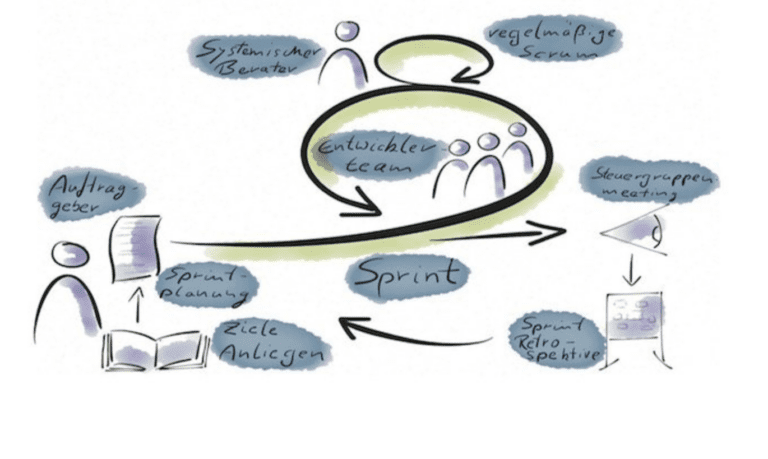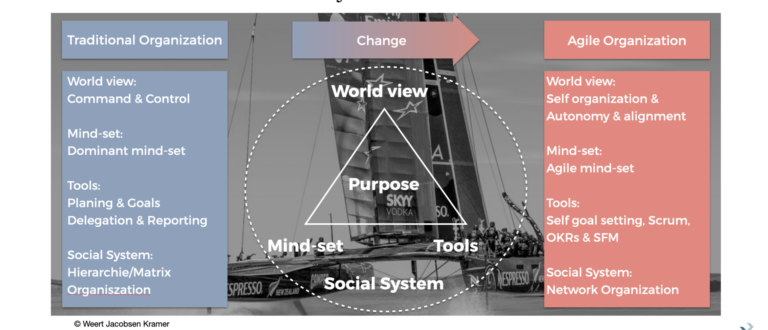Hybrid project management
How do you achieve better planning and control with shop floor management in project development?
How can classic development processes be transferred to agile project management?
1. Situation
The biggest lever for project success lies in planning. Regardless of the project management approach, careful planning is important in any project.
At the beginning of a project, the possibility of influencing the project product outcome is high. The later changes are made to the project product result, the higher the change effort becomes.
By short-cycle agile approach in the project, we can reduce the risk of making irreversible mistakes. But a product cannot be divided into arbitrarily small increments. Therefore, we also reach limits in agile planning, as every project generally goes through the following project phases:
- Define
- Concept
- Realize
- Verify
- Deliver
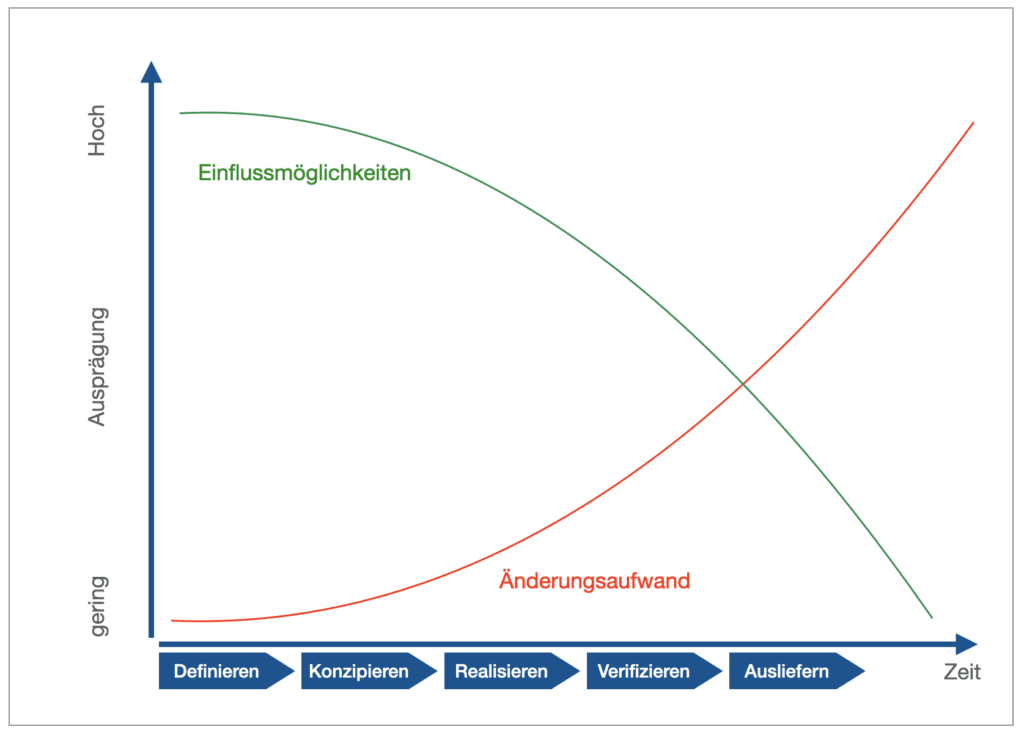
2. Complication
In practice, the question of the right process model now arises in view of the increasingly complex product development processes.
The process model
The process model must match to task environment. We distinguish between different process models:
- Plan-driven procedure (e.g. nuclear power plant)
- Incremental procedure (e.g. production)
- Interative procedure (e.g. prototype construction)
- Agile approach (e.g. software development)
Despite the popularity of the agile approach, it is always necessary to check for each project which process model is best suited to the situation and the task environment.
If the Lean principles are consistently implemented in project management, an agile approach is created in principle. The lean principles are:
- Flow
- tact
- pull
- Freedom from disturbance
However, the choice of approach still depends on the situation and the framework conditions.
In the construction of a nuclear power plant, there are many tough conditions to be met. Wrong decisions in planning can be extremely expensive. Here, a classic, plan-driven approach is recommended.
In software development, the agile procedure model is undoubtedly possible without any problems. There are hardly any restrictions due to hardware and the employees are usually easy to deploy in interdisciplinary.
In mass production we find the incremental approach. Deliverables are produced that the customer can use immediately, with the product features being continuously changed by improvements within narrow limits.
Prototyping is a good example of the iterative approach. Here, changes are made to the product at a higher frequency, and usually at unit number 1. The delivery frequency is therefore extremely low.
In automotive development and manufacturing, there are severe constraints due to hardware and production locations and supply chains. Here, a pure agile approach reaches its limits because it has to be reconciled with the maturity-driven product development process. This is where the hybrid project management method comes in handy, as discussed below.
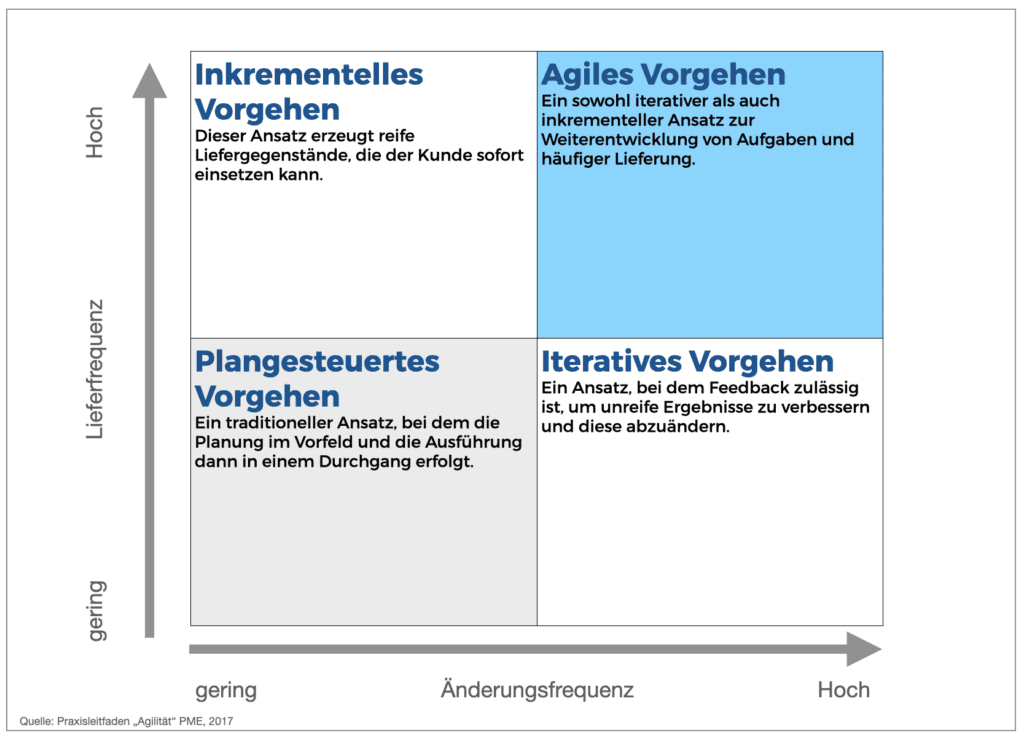
The product development process (PDP) is becoming increasingly complex.
Vehicle development in the automotive industry is a good example of rapidly increasing complexity. Vehicles are increasingly understood as a system of systems that interact with each other. The subsystems in turn have different life cycles.
- e.g. IT components will soon account for 50% of a vehicle’s components.
- e.g. Level 5 autonomous driving required up to 1 billion lines of software code.
- e.g. modern premium vehicles contain approx. 150 ECUs, in some cases 2 engines (1 ICE, 1 Electric), 12 radar/ultrasonic sensors for autonomous driving, 9 cameras, complex head-up displays and infotainment features
- e.g., in total, many hundreds of systems with many functions interlock, which have corresponding dependencies among each other.

The increasing complexity in the development process (PDP) therefore requires a high interdisciplinary collaboration effort and requires short-cycle coordination of all trades.
From a lean management perspective, the increasing collaboration effort is a form of necessary waste, which we need for higher flexibility and speed. However, it must be reduced and optimized.
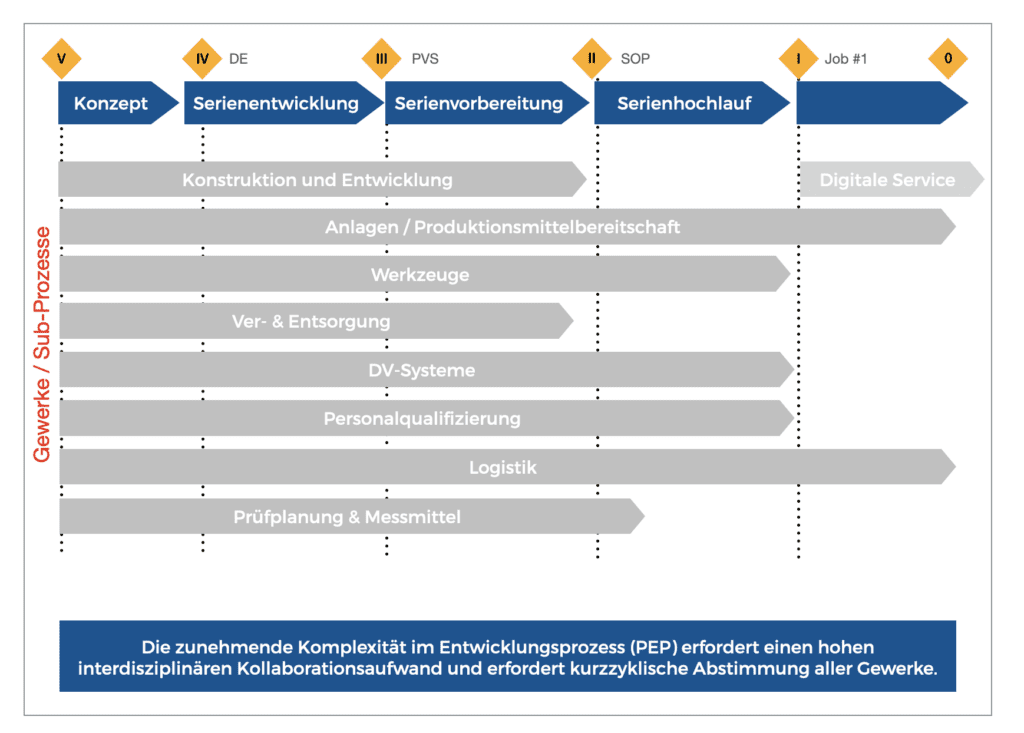
3. Solution: hybrid project management
The question now arises as to how classic maturity-oriented development can be transferred to agile project management.
The answer to this question is that the maturity-oriented development plan from project planning is implemented with the agile process model in project control. This creates an effective hybrid in project management.
In essence, we combine short-cycle sprints, in which marketable increments are produced, with sequential project phases. Planning is carried out according to maturity-oriented development planning, but project control is carried out using the agile process model, which is implemented with effective store floor management.
The product requirements are defined from the respective downstream process step. The “customer” is the respective successor in the development step. Here, the project team is always guided by the key questions:
- Who is my customer?
- What are the requirements for the increment?
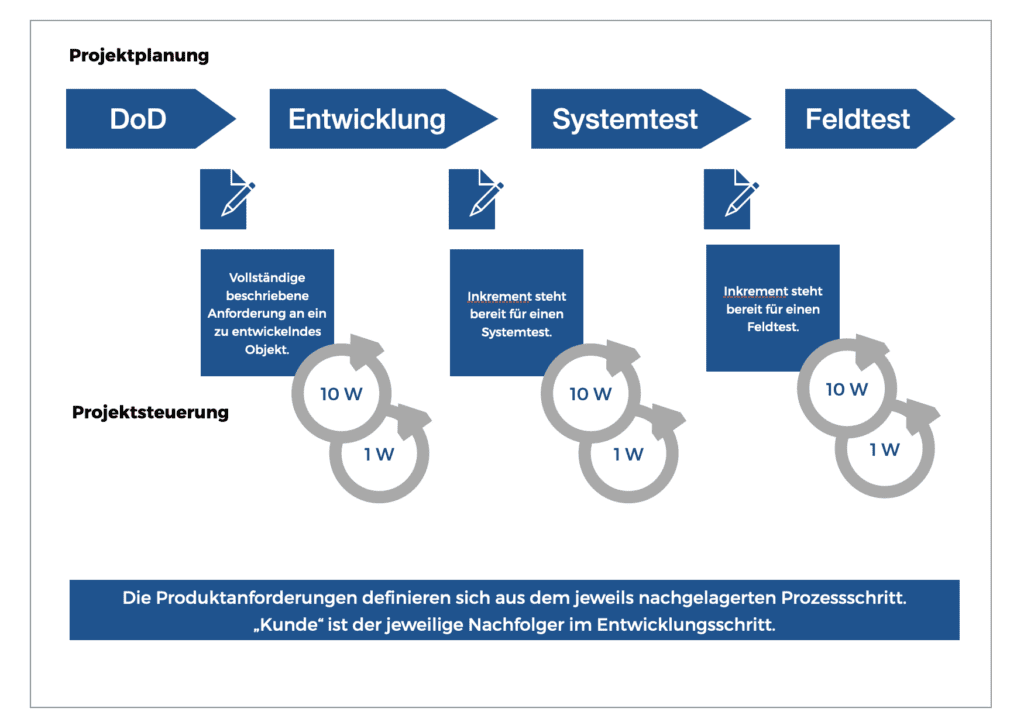
Planning Paradox
In project management, we can observe a paradoxical situation. The more precisely you plan, the less precise the planning becomes, because the planning status has to be constantly changed due to changes in the outside world. To use the words of my esteemed colleague Dr Andreas Romberg: “The more precisely you plan, the harder chance hits you!”
Therefore, we need a planning principle that, on the one hand, ensures reliable long-term planning and, on the other hand, enables control despite changes in the environment.
Rolling Planning Principle
The principle of rolling planning enables us to achieve a balance between long-term and medium-term planning and short-term control. The logic of rolling planning can best be derived from the “Rule of 10”.
The rule of 10
This logic can be easily remembered via the “Rule of 10”. A rolling plan plans from the current week/month into the future. Rolling planning with the 10-rule is based on this scheme:
- 10 months (multi-project planning)
- 10 weeks (project planning)
- 10 days = 2 weeks (project control)
- 1 week (project cycle)
The (multi)project planning covers the period 10+ months. This planning is usually created in a project planning tool. Key work packages and milestones are recorded in a project schedule.
In the 10 weeks project planning, dependencies between work packages are constantly rebalanced.
The team leader leads his team operationally in the project control with the time horizon of 10 days (2 weeks).
The project cycle in project control is the respective work week. The manager organizes himself and the team within the work week in such a way that the respective work results can be achieved.
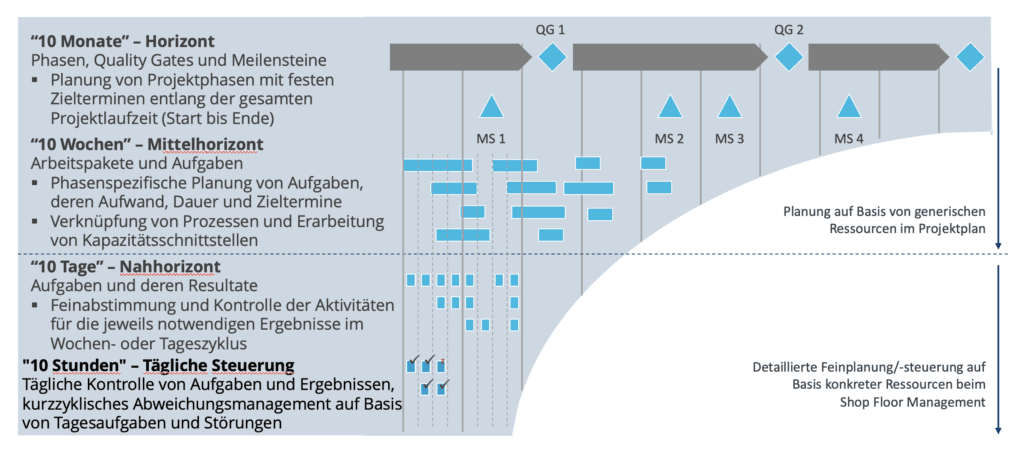

Contact us now!
We have more than 20 years of experience and deliver high quality consulting for your Agile, Lean or Digital Transformation.
Restriction: “Hikes” instead of “Sprints
Agile evangilists will rightly criticize the following concept that it is no longer agile project management of the pure doctrine. Yes this is so.
The reality of the development environment in many companies, such as the German automotive industry, is characterized by the fact that two of the essential prerequisites for agile project management cannot always be met:
No freedom from disruption.
It is still often the case that freedom from disruption is not guaranteed in the development process. This means that due to an overall lack of process stability, there are always changes in the project planning that cause disruptions in the ongoing development project due to changing DoD. The idea of e.g. 14 days of concentrated sprint phase without influences by product owners or other stakeholders is mostly not realistic.
Specialist teams or high proportion of specialists in interdisciplinary teams
It is true that more and more companies are dissolving their specialist teams of the classic silo/matrix organization in favor of interdisciplinary, cross-functional teams. Nevertheless, many of the employees working in these teams are currently highly qualified due to years of working in specialized teams. This specialization hinders collaboration in cross-functional teams, because it creates natural bottlenecks for individual people. Therefore, the implementation of sprints reaches its limits here due to the different capacities and resource bottlenecks.
Hike’s instead of Sprints
To address this reality, we decided to introduce the term “Hike”. Hike’s are hikes or marches and are to be distinguished from Sprints, which require disruption-free periods of e.g. 2-3 weeks.
Hikes are therefore the constant processing of tasks in the development teams, which, perhaps interrupted by vacations, training or strategy meetings, basically takes place continuously throughout the year.
Hikes are not disruption-free and do not have to be limited to a specific period of time. However, hikes can be divided into “stages” with intermediate goals.
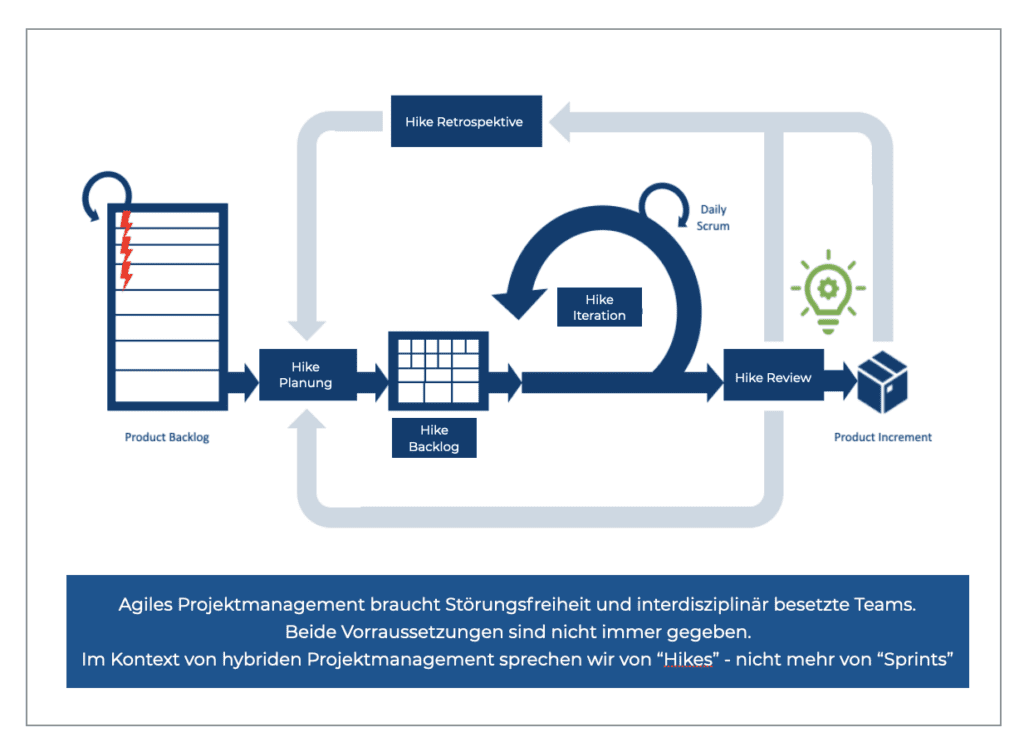
Hybrid project management needs four elements in its implementation
Four elements are needed to implement hybrid project management. These four elements are implemented in the context of a Shopfloor Management cascade. (see next point)
Maturity levels of development with DoD
We need a precise sequential arrangement of maturity levels and definition of acceptance criteria per maturity level. We need a precise description of general stages and intermediate goals.
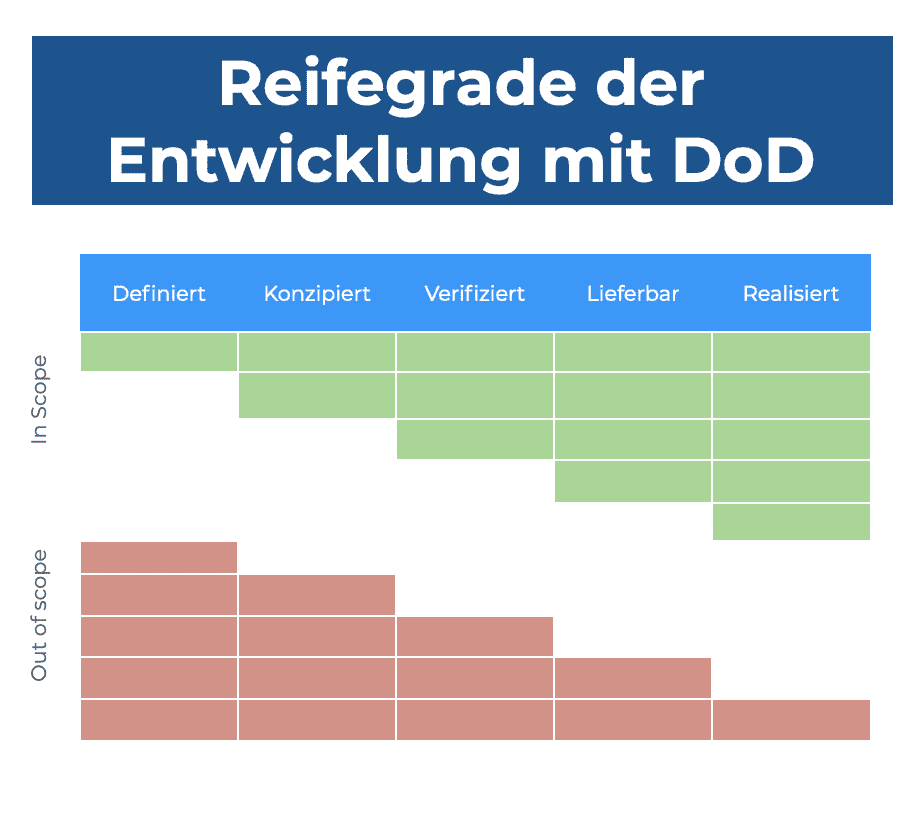
Product Backlog
We need a structured listing and time prioritization of the product increments to be developed in the product backlog or work breakdown structure.
The “Definition of Done” is applied and scaled to all specific product increments.
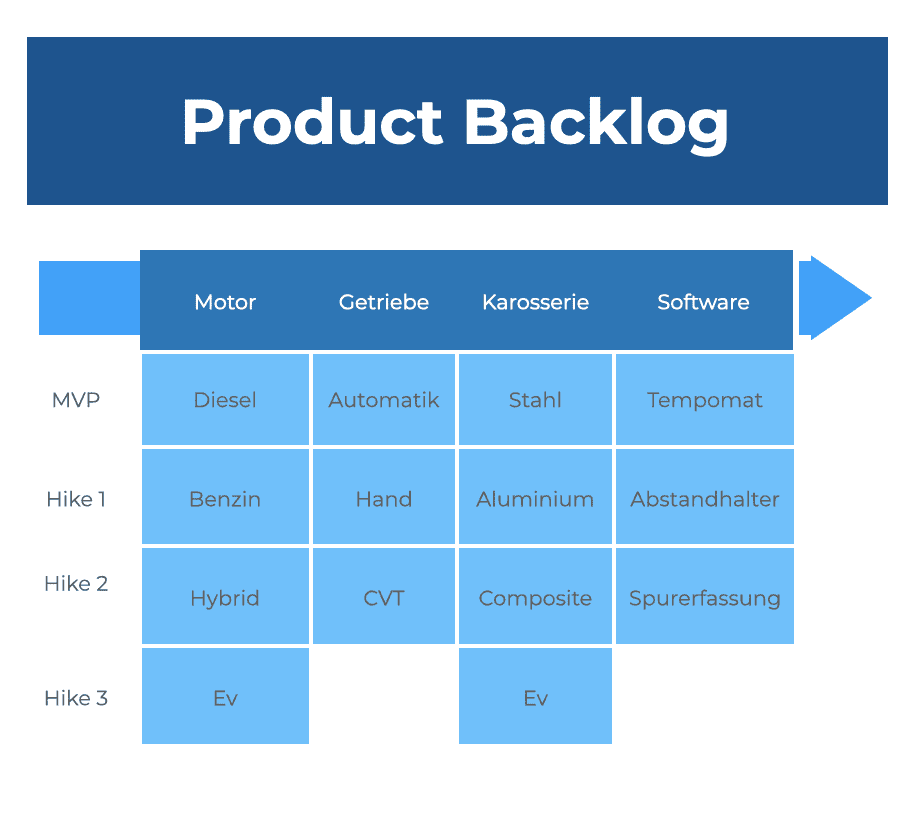
Hike Backlog
As part of the project implementation, the relevant product increments are presented in the Hike Backlog for the next hike. The current maturity level is visualized. For each product increment there is a clear agreement on the target maturity level at the end of the hike.
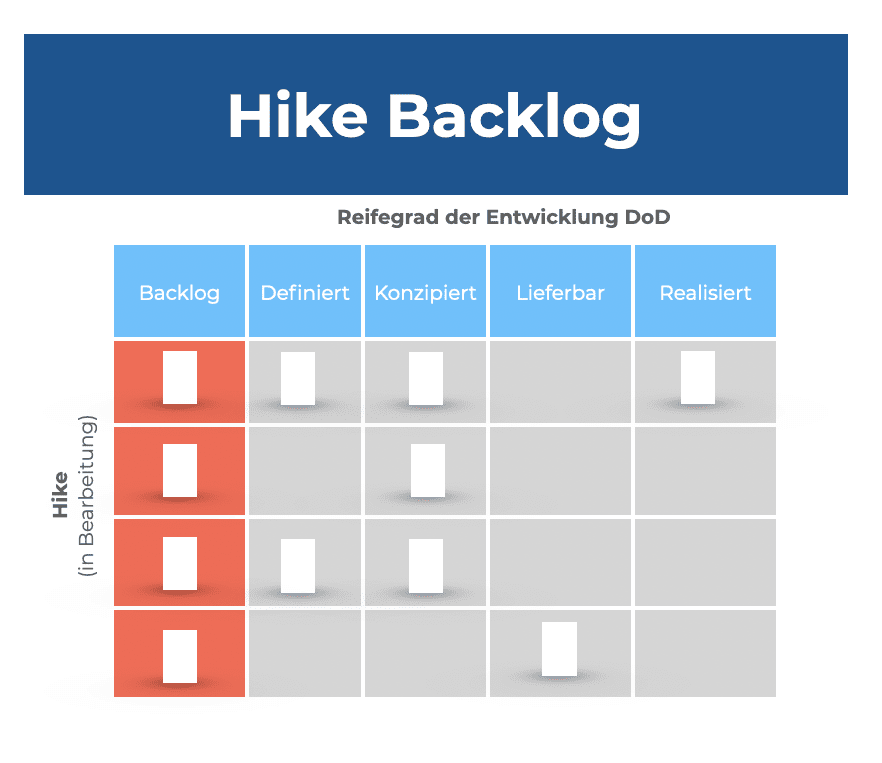
Hike Plan
Schließlich brauchen wir noch eine zeitlich, chronologisch, vernetzte Planung der Aufgaben zur Erreichung des jeweiligen Etappen-Ziels. Diese Planung übernimmt das interdisziplinär besetzte Entwicklungsteam. Es definiert Start – und Endtermine für alle Aufgaben und legt die Verantwortlichen fest.
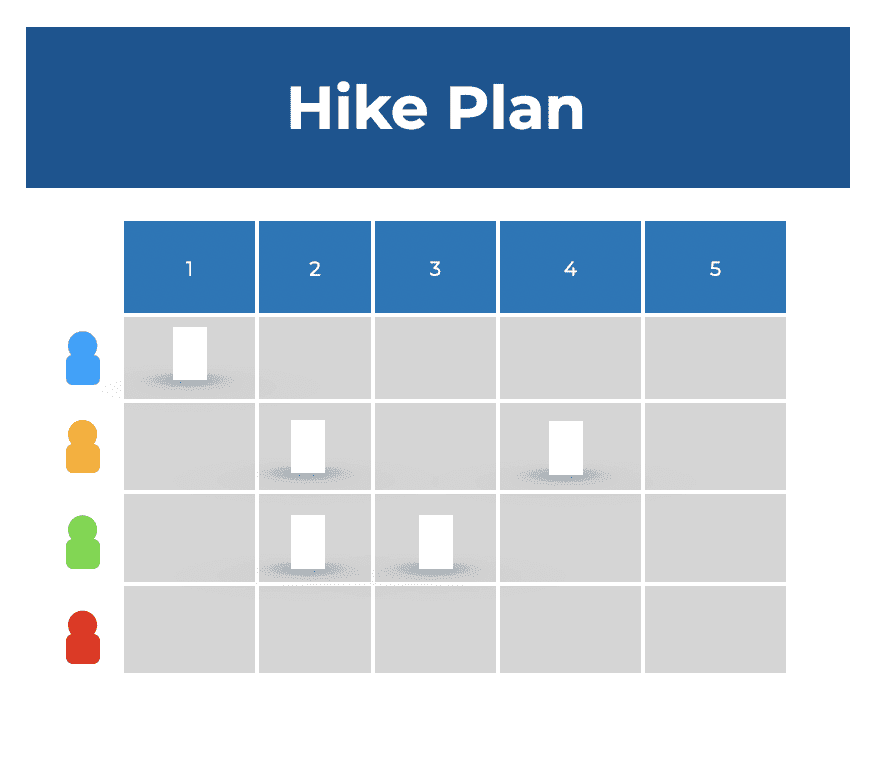
4. The next step is the implementation of hybrid project management with the help of store floor management.
At the end of the day, all the discussion about process models in project management is about getting horsepower on the road. Most companies have less of a “planning problem” than an “implementation problem.”
At the end of the day, it’s about working through the work packages as a team in the context of successful collaboration. This should be fun and satisfying for everyone involved. This requires good leadership at the point of action. The essential task of leadership is to control the target-actual deviation in order processing and to remedy it at an early stage and to establish successful collaboration together with the team.
In essence, therefore, it is a matter of linking project planning and project control.
Step 1: Hike planning – definition of hike scope
The scope of the hike is defined by specifying who works on which product increment with which goal. The processing of the hike objectives is checked with maturity levels (doD) at phase transition.
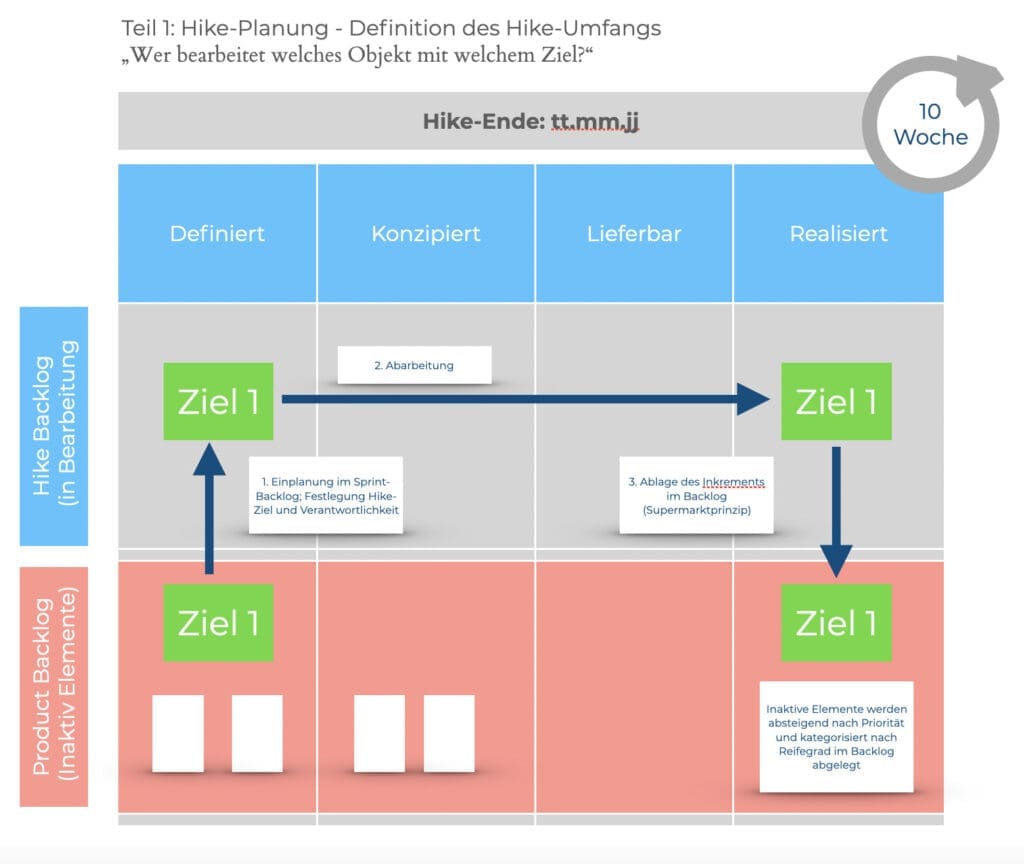
Step 2: Networked hike planning in the interdisciplinary team
As a basis for detailed planning/control, a generation of linked tasks per process phase takes place within the framework of shop floor management.
The interdisciplinary development team distributes the tasks to the team members and defines who delivers what by when.
This planning takes place within the framework of rolling planning over 10 weeks, 10 days up to daily planning together with the team.
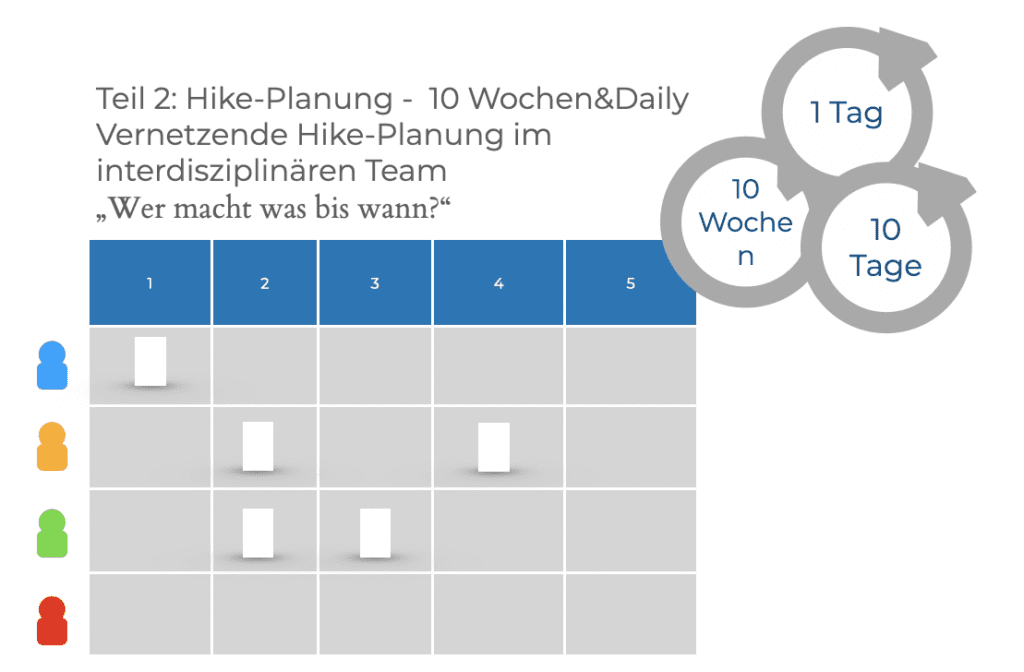
Step 3: Hike-Management
Further detailed planning and control of the tasks (requirements) takes place on the weekly shop floor to achieve the hike targets. A work week corresponds to the basic cycle in product development.
In the weekly hike control, the current and the following two weeks are planned on a rolling basis, or the significant deviations from the target-actual are controlled and escalated if necessary.
The manager creates commitment in the meetings by focusing on the top issues, agreeing on Go&See and providing feedback on initiated actions. At the same time, process performance is objectified with selected key figures (hit rate, degree of disruption, mood).
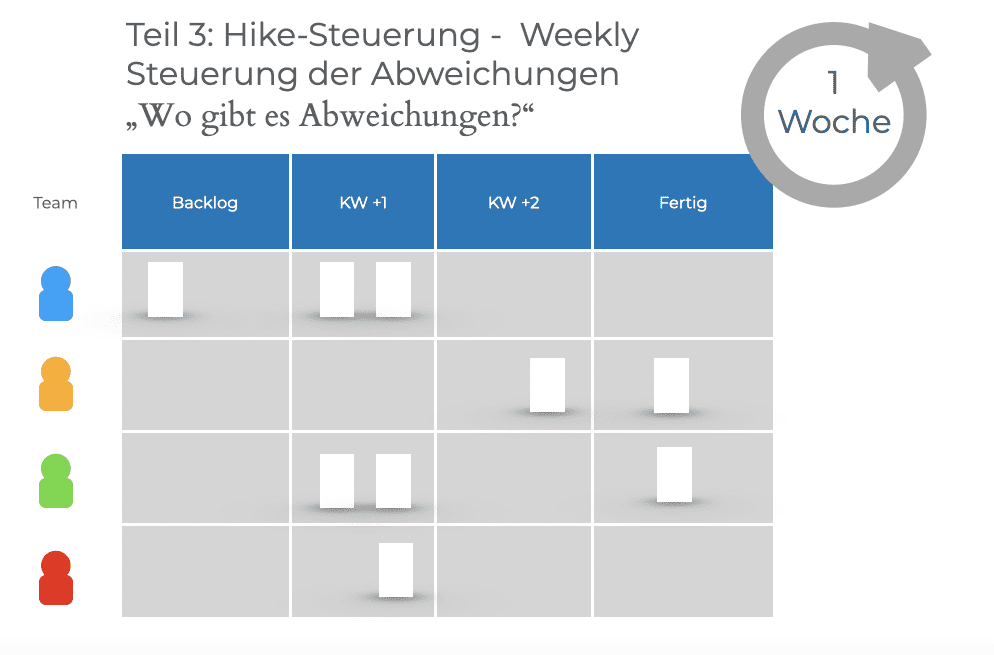
Hybrid planning creates trust
Through constant collaboration in joint planning based on rolling planning using the Rule of 10, confidence in project collaboration increases in the organization.
Because all players learn that neither too much nor too little planning is done, and that important work packages are only started when the time is right so that time-consuming rework is eliminated, all participants can engage in this planning. Everyone trusts each other that everyone will deliver their work packages at the right time.
Key performance indicators versus Key Result indicators
In hybrid project management, corresponding key performance indicators ensure that all participants retain control over the overall process. Key performance indicators must be distinguished from key result indicators.
Key performance indicators refer to facts that can no longer be changed. Control indicators refer to facts that can be influenced. They are indicators of potential risks and enable measures to be taken.
Examples of key performance indicators are:
- Milestone analysis
- Percentage of supplier commitments met
- Percentage of completed measures in case of deviations
- Percentage of executable work packages (assignments made ready)
- Delivery reliability (on-time delivery)
- Percentage plan complete (PPC)
- On-time delivery of assignment packages
- Personnel strength plan/target
- Delay and disruption analysis
- Opportunities & risks (savings/extra costs)
- Deficiencies
- Planned delivery list is/should be
- Obstruction notices
- Workload is/should be
- Plan adjustments
- Productivity
- Billable services
- First time right (Quality Gate)
Digital Shopfloor Management
Of course, the digitalization of the working world does not stop at the topic of store floor management. Just like the project management solutions mentioned above, there are now a whole range of software projects and software products that specialize in the implementation of digital shopfloor management (dSFM).
The difference between pure project management solutions and shop floor management solutions lies in the integration of KPI dashboards, CIP process, PDCA cycle, problem solving, escalation logic and capacity control, among other things. dSFM solutions are geared towards deviation management.
Ideally, the project management solution and the store floor management solution can be linked together via an interface, as the all-in-one solution does not yet exist on the market. In this case, the project milestones and task packages and their status are regularly synchronized between the two systems.
We would very much like to mention ValueStreamer as a possible alternative. This software optimally covers the needs of operational control in terms of shop floor management. Anyone looking for a quick, uncomplicated start in the world of dSFM is very well positioned with ValueStreamer.

Summary
Planning is an essential part of project management. It is necessary to select the right approach for the situation and task from various process models.
The hybrid project management approach is a solution for the increasing complexity in the product development process (PDP). At its core, we combine short-cycle “hikes”, in which marketable increments are produced, with sequential project phases. Planning is carried out according to maturity-oriented development planning, but project control is carried out using the agile process model, which is implemented with effective store floor management.
Since we cannot fully meet the prerequisites for agile project management in the context of hybrid project management, we speak of “hikes” instead of “sprints”. For the implementation we need four elements: maturity model, product backlog, hike backlog, hike plan.
While the maturity-oriented development plan is used for planning, the control of the processing of tasks takes place via shop floor management, which is oriented to the agile process model.
This requires good leadership at the point of action. The essential task of leadership is to control the target-actual deviation in order processing and to remedy it at an early stage and to establish successful collaboration together with the team.

Contact us now!
We have more than 20 years of experience and deliver high quality consulting for your Agile, Lean or Digital Transformation.


